Also on this day. in 1276, Sir John Deyville paid 578 marks to 'Peter Beset or to the abbot of St Mary's York'. In exchange he gained the right to recover his Yorkshire manor of Thornton-on-the Hill in Yorkshire. This sum was roughly equivalent to £400.
John was a former Montfortian rebel who had caused enormous damage and loss of life in the civil wars. He had acted as Simon's viceroy in northern England, occupying York in defiance of Henry III. He and his followers had roved all over England, burning towns as far afield as Scarborough, Sheffield, Lincoln and Canterbury, among other places. They also waged guerrilla warfare against Henry's son, Lord Edward, attacking his Italian creditors on the Great North Road between London and York. At Lincoln they destroyed the Jewish quarter, slaughtering the Jewish population and burning the records of Christian debts. Their own debts, needless to say.
John finally submitted in 1267, and was forced to pay a series of redemption fines to the queen, Eleanor of Provence. The payment to St Mary's bears a striking parallel to an early Robin Hood ballad, in which the outlaw entertains an impoverished knight. Robin takes pity on the knight and lends him the £400 he needs to redeem pledged lands from the abbot of St Mary's, York. Such a contract was unlikely after 1279, after which restrictions on lending were imposed on religious houses by the Statute of Mortmain.
In later versions of the legend the 'poor knyghte' acquires a name, Sir Richard Atte Lee or Sir Richard of the Lea. This was because two separate manuscripts, recording the deeds of Robin Hood, were stitched together to form a single narrative.






